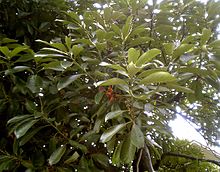Lithocarpus
| Lithocarpus Temporal range:
| |
|---|---|

| |
| Lithocarpus edulis, Kantō region, Japan | |
| Scientific classification | |
| Kingdom: | Plantae |
| Clade: | Tracheophytes |
| Clade: | Angiosperms |
| Clade: | Eudicots |
| Clade: | Rosids |
| Order: | Fagales |
| Family: | Fagaceae |
| Subfamily: | Quercoideae
|
| Genus: | Lithocarpus Blume |
| Species | |
|
See text | |
| Diversity | |
| c. 340 species | |
| Synonyms | |
|
Pasania Oerst. | |
Lithocarpus is a genus in the
The North American
Lithocarpus trees are
Several of the species are very attractive ornamental trees, used in parks and large gardens in warm temperate and subtropical areas.
Classification
In 1948,
Her classification system included 13 subgenera, including the subgenus Pasania which is by far the largest division within the genus. About 100 Asian species were treated separately in Pasania, at the genus level, and occasionally the old name persists on some herbarium sheets that have not been annotated. Several of the other subgenera possess fewer than ten species and have distinctive morphologies. Few of the Malesian species are treated in Camus' system and Soepadmo, who wrote the Flora Malesiana treatment,[10][11] made no attempt to update or integrate these species into Camus' system, therefore a lot of work obviously remains to be done. Camus' system was highly detailed, as three levels of organization are recognized below the subgenus, but the classification is not systematic at the lowest level.
List of subgenera (No. of species in Camus' treatment): Castanicarpus (1); Corylopasania (2); Cryptostylis (1); Cyclobalanus (58); Cyrtobalanus (1); Eulithocarpus (11); Gymnobalanus (10); Liebmannia (3); Oerstedia (1); Pachybalanus (14); Pasania (209); Pseudosynaedrys (9); Synaedrys (15); indeterminate (12).
Early researchers into the family often suggested that the stone oaks were primitive in the family. An exhaustive study of the inflorescence and fruits of 73 species from eight of Camus' subgenera found that important development and evolutionary characters distinguish the major groups in the genus and indicate differences among the genera of the family.
Species


References
- ^ Strijk, J.S. (September 4, 2018). "Lithocarpus - On: asianfagaceae.com – The complete database for information on the evolutionary history, diversity, identification and conservation of over 700 Species of Asian trees". Asian Fagaceae. Retrieved May 4, 2021.
- ISSN 2296-701X.
- .
- S2CID 86444402. Retrieved 2020-03-23.
- PMID 32442164.
- S2CID 85671229. Archived from the original(PDF) on 2017-03-20. Retrieved 2014-03-05.
- PMID 22457722.
- . Retrieved 2020-03-20.
- OCLC 496212700.
- OCLC 475354541.
- OCLC 8642966464.
External links
- Individual species are described in detail on www.asianfagaceae.com.
- A full list of the species and their synonyms can be seen by entering Lithocarpus in the search box in the World Checklist
- Flora of China Online includes descriptions of the 123 Chinese species
